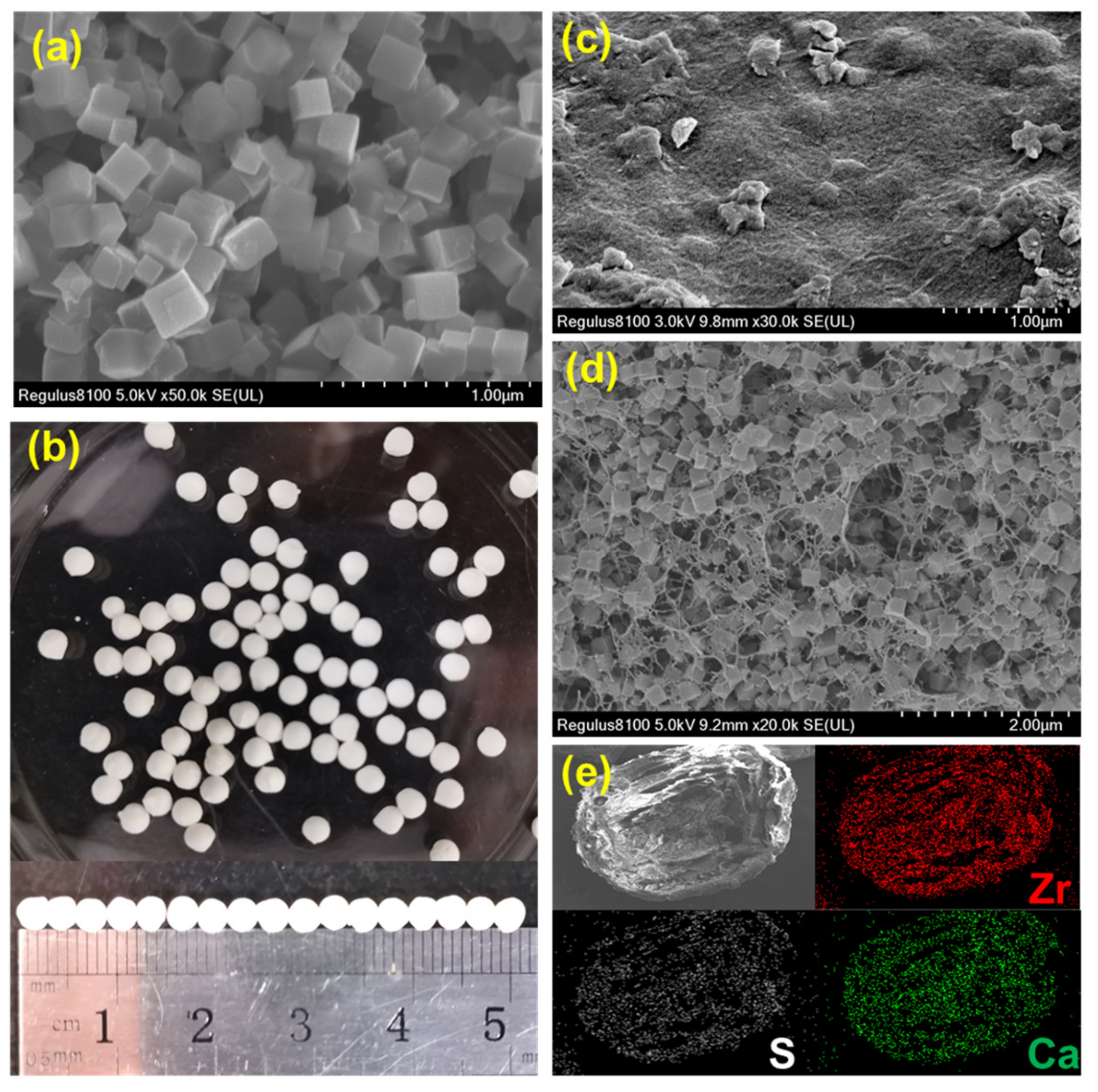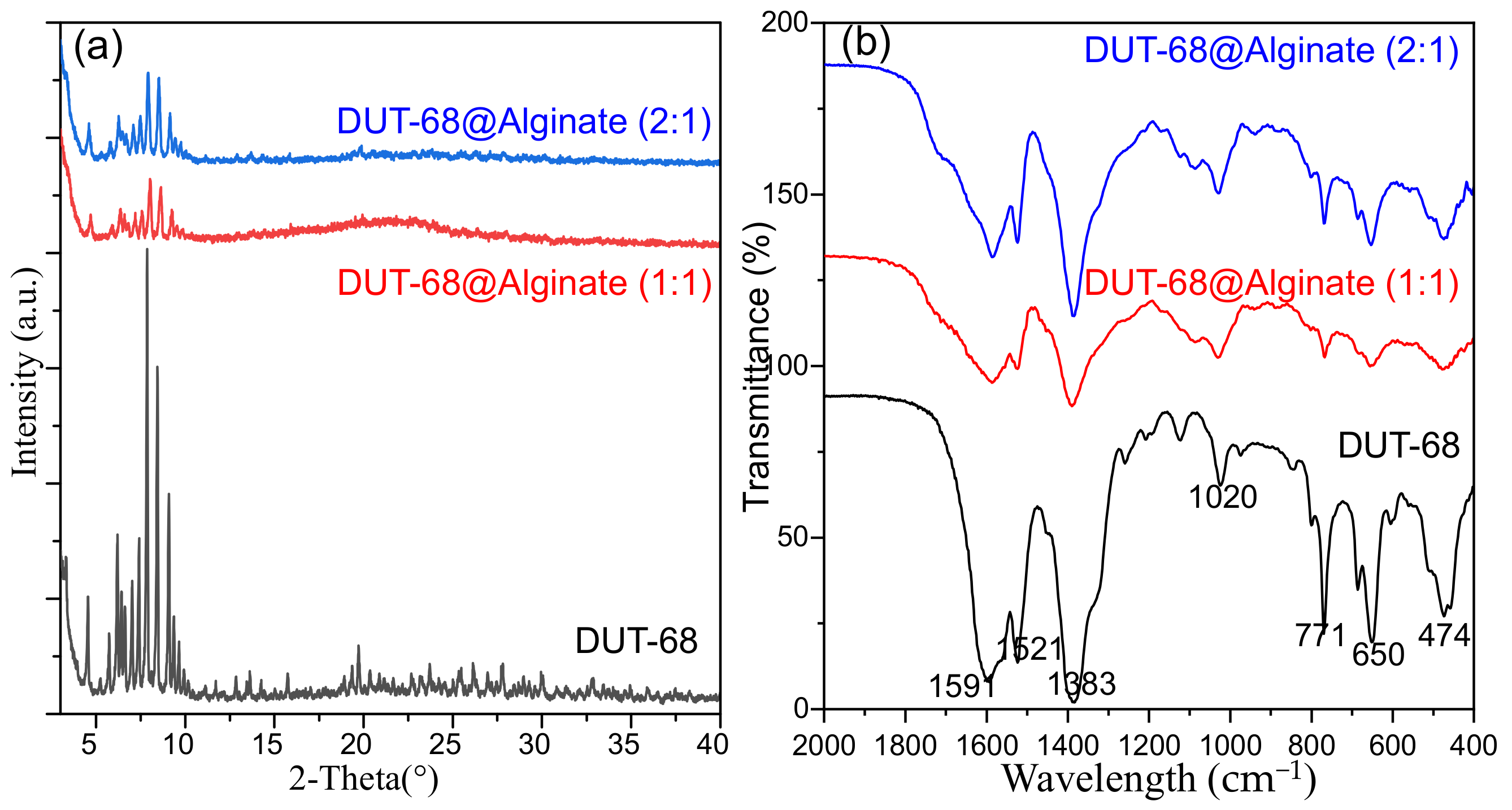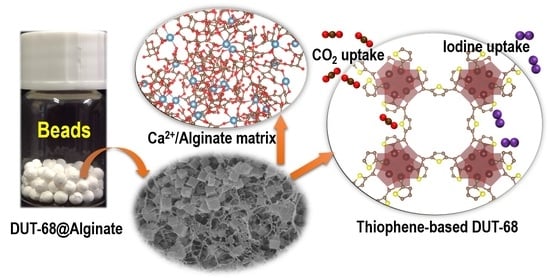Preparation of Highly Porous Thiophene-Containing DUT-68 Beads for Adsorption of CO2 and Iodine Vapor
Abstract
:1. Introduction
2. Experiments
2.1. Synthesis of DUT-68@Alginate Beads
2.2. Characterization
3. Results and Discussion
4. Conclusions
Author Contributions
Funding
Conflicts of Interest
References
- Li, Z.; Sun, W.; Chen, C.; Guo, Q.; Li, X.; Gu, M.; Feng, N.; Ding, J.; Wan, H.; Guan, G. Deep eutectic solvents appended to UiO-66 type metal organic frameworks: Preserved open metal sites and extra adsorption sites for CO2 capture. Appl. Surf. Sci. 2019, 480, 770–778. [Google Scholar] [CrossRef]
- Park, J.M.; Yoo, D.K.; Jhung, S.H. Selective CO2 adsorption over functionalized Zr-based metal organic framework under atmospheric or lower pressure: Contribution of functional groups to adsorption. Chem. Eng. J. 2020, 402, 126254. [Google Scholar] [CrossRef]
- Chen, P.; He, X.; Pang, M.; Dong, X.; Zhao, S.; Zhang, W. Iodine Capture Using Zr-Based Metal–Organic Frameworks (Zr-MOFs): Adsorption Performance and Mechanism. ACS Appl. Mater. Interfaces 2020, 12, 20429–20439. [Google Scholar] [CrossRef] [PubMed]
- Wang, K.; Tang, Y.; Jiang, Q.; Lan, Y.; Huang, H.; Liu, D.; Zhong, C. A thiophene-containing covalent triazine-based framework with ultramicropore for CO2 capture. J. Energy Chem. 2017, 26, 902–908. [Google Scholar] [CrossRef] [Green Version]
- Shao, L.; Sang, Y.; Liu, N.; Wei, Q.; Wang, F.; Zhan, P. One-step synthesis of N-containing hyper-cross-linked polymers by two crosslinking strategies and their CO2 adsorption and iodine vapor capture. Sep. Purif. Technol. 2021, 262, 118352. [Google Scholar] [CrossRef]
- Pourebrahimi, S.; Pirooz, M. Reversible iodine vapor capture using bipyridine-based covalent triazine framework: Experimental and computational investigations. Chem. Eng. J. Adv. 2021, 8, 100150. [Google Scholar] [CrossRef]
- Kidanemariam, A.; Lee, J.; Park, J. Recent Innovation of Metal-Organic Frameworks for Carbon Dioxide Photocatalytic Reduction. Polymers 2019, 11, 2090. [Google Scholar] [CrossRef] [Green Version]
- Junghans, U.; Kobalz, M.; Erhart, O.; Preißler, H.; Lincke, J.; Möllmer, J.; Krautscheid, H.; Gläser, R. A Series of Robust Copper-Based Triazolyl Isophthalate MOFs: Impact of Linker Functionalization on Gas Sorption and Catalytic Activity. Materials 2017, 10, 338. [Google Scholar] [CrossRef] [Green Version]
- Yoon, S.-S.; Lee, H.-K.; Hong, S.-R. CO2/N2 Gas Separation Using Pebax/ZIF-7—PSf Composite Membranes. Membranes 2021, 11, 708. [Google Scholar] [CrossRef]
- Qin, L.; Xu, G.-j.; Yao, C.; Xu, Y.-h. Thiophene-based conjugated microporous polymers: Preparation, porosity, exceptional carbon dioxide absorption and selectivity. Polym. Chem. 2016, 7, 4599–4602. [Google Scholar] [CrossRef]
- Bon, V.; Senkovska, I.; Baburin, I.A.; Kaskel, S. Zr- and Hf-Based Metal–Organic Frameworks: Tracking Down the Polymorphism. Cryst. Growth Des. 2013, 13, 1231–1237. [Google Scholar] [CrossRef]
- Kundu, S.K.; Bhaumik, A. Novel Nitrogen and Sulfur Rich Hyper-Cross-Linked Microporous Poly-Triazine-Thiophene Copolymer for Superior CO2 Capture. ACS Sustain. Chem. Eng. 2016, 4, 3697–3703. [Google Scholar] [CrossRef]
- Wang, L.; Li, T.; Dong, X.; Pang, M.; Xiao, S.; Zhang, W. Thiophene-based MOFs for iodine capture: Effect of pore structures and interaction mechanism. Chem. Eng. J. 2021, 425, 130578. [Google Scholar] [CrossRef]
- Rege, S.U.; Yang, R.T. Corrected Horváth-Kawazoe equations for pore-size distribution. AIChE J. 2000, 46, 734–750. [Google Scholar] [CrossRef] [Green Version]
- Yu, M.-H.; Zhang, P.; Feng, R.; Yao, Z.-Q.; Yu, Y.-C.; Hu, T.-L.; Bu, X.-H. Construction of a Multi-Cage-Based MOF with a Unique Network for Efficient CO2 Capture. ACS Appl. Mater. Interfaces 2017, 9, 26177–26183. [Google Scholar] [CrossRef]
- Yang, S.; Peng, L.; Syzgantseva, O.A.; Trukhina, O.; Kochetygov, I.; Justin, A.; Sun, D.T.; Abedini, H.; Syzgantseva, M.A.; Oveisi, E.; et al. Preparation of Highly Porous Metal–Organic Framework Beads for Metal Extraction from Liquid Streams. J. Am. Chem. Soc. 2020, 142, 13415–13425. [Google Scholar] [CrossRef]
- Wang, L.; Chen, P.; Dong, X.; Zhang, W.; Zhao, S.; Xiao, S.; Ouyang, Y. Porous MOF-808@PVDF beads for removal of iodine from gas streams. RSC Adv. 2020, 10, 44679–44687. [Google Scholar] [CrossRef]
- Moulder, J.F. Handbook of X-Ray Photoelectron Spectroscopy. Phys. Electron. 1995, 230–232. [Google Scholar]
- Wang, H.; Bo, X.; Zhou, M.; Guo, L. DUT-67 and tubular polypyrrole formed a cross-linked network for electrochemical detection of nitrofurazone and ornidazole. Anal. Chim. Acta 2020, 1109, 1–8. [Google Scholar] [CrossRef]
- Sangeetha Margreat, S.; Ramalingam, S.; Sebastian, S.; Xavier, S.; Periandy, S.; Daniel, J.C.; Maria Julie, M. DFT, spectroscopic, DSC/TGA, electronic, biological and molecular docking investigation of 2,5-thiophenedicarboxylic acid: A promising anticancer agent. J. Mol. Struct. 2020, 1200, 127099. [Google Scholar] [CrossRef]
- Rapti, S.; Pournara, A.; Sarma, D.; Papadas, I.T.; Armatas, G.S.; Hassan, Y.S. Rapid, green and inexpensive synthesis of high quality UiO-66 amino-functionalized materials with exceptional capability for removal of hexavalent chromium from industrial waste. Inorg. Chem. Front. 2016, 3, 635–644. [Google Scholar] [CrossRef]
- Yang, N.; Wang, R.; Rao, P.; Yan, L.; Zhang, W.; Wang, J.; Chai, F. The Fabrication of Calcium Alginate Beads as a Green Sorbent for Selective Recovery of Cu(II) from Metal Mixtures. Crystals 2019, 9, 255. [Google Scholar] [CrossRef] [Green Version]
- Xia, Y.; Zhu, Y.; Tang, Y. Preparation of sulfur-doped microporous carbons for the storage of hydrogen and carbon dioxide. Carbon 2012, 50, 5543–5553. [Google Scholar] [CrossRef]
- Zhou, F.; Zhou, J.; Gao, X.; Kong, C.; Chen, L. Facile synthesis of MOFs with uncoordinated carboxyl groups for selective CO2 capture via postsynthetic covalent modification. RSC Adv. 2017, 7, 3713–3719. [Google Scholar] [CrossRef] [Green Version]
- Yue, M.B.; Sun, L.B.; Cao, Y.; Wang, Z.J.; Wang, Y.; Yu, Q. Promoting the CO2 adsorption in the amine-containing SBA-15 by hydroxyl group. Microporous Mesoporous Mater. 2008, 114, 74–81. [Google Scholar] [CrossRef]
- Chen, Y.; Shao, G.; Kong, Y.; Shen, X.; Cui, S. Facile preparation of cross-linked polyimide aerogels with carboxylic functionalization for CO2 capture. Chem. Eng. J. 2017, 322, 1–9. [Google Scholar] [CrossRef]
- Yang, J.; Yan, X.; Xue, T.; Liu, Y. Enhanced CO2 adsorption on Al-MIL-53 by introducing hydroxyl groups into the framework. RSC Adv. 2016, 6, 55266–55271. [Google Scholar] [CrossRef]
- Li, C.; Li, P.; Chen, L.; Briggs, M.E.; Liu, M.; Chen, K.; Shi, X.; Han, D.; Ren, S. Pyrene-cored covalent organic polymers by thiophene-based isomers, their gas adsorption, and photophysical properties. J. Polym. Sci. Part A Polym. Chem. 2017, 55, 2383–2389. [Google Scholar] [CrossRef]
- Bolotov, V.A.; Kovalenko, K.A.; Samsonenko, D.G.; Han, X.; Zhang, X.; Smith, G.L.; McCormick, L.J.; Teat, S.J.; Yang, S.; Lennox, M.J.; et al. Enhancement of CO2 Uptake and Selectivity in a Metal–Organic Framework by the Incorporation of Thiophene Functionality. Inorg. Chem. 2018, 57, 5074–5082. [Google Scholar] [CrossRef] [Green Version]
- Wang, F.; Kusaka, S.; Hijikata, Y.; Hosono, N.; Kitagawa, S. Development of a Porous Coordination Polymer with a High Gas Capacity Using a Thiophene-Based Bent Tetracarboxylate Ligand. ACS Appl. Mater. Interfaces 2017, 9, 33455–33460. [Google Scholar] [CrossRef]






| Adsorbents | SBET (m2/g) | Vtotal (cc/g) | Temp. (K) | Pressure (bar) | S Element Content (wt.%) | CO2 Adsorption Capacity (mmol/g) | CO2/S Molar Ratio |
|---|---|---|---|---|---|---|---|
| HMC-1 [12] | 855 | 0.297 | 273 | 1 | 27.1 | 5.00 | 0.59 |
| SCMP-COOH@1 [10] | 911 | 273 | 1 | 16.86 | 2.14 | 0.41 | |
| CTF-DCBT [4] | 500 | 0.26 | 298 | 1 | 12.61 | 1.69 | 0.43 |
| CK-COP-2 [28] | 615 | 0.68 | 273 | 1 | 24.16 | 2.13 | 0.28 |
| Zn2(tdc)2DABCO [29] | 1553 | 0.68 | 273 | 1 | 10.9 | 6.82 | 2.17 |
| Cu6(DDC)3 [30] | 2410 | 0.98 | 273 | 1 | 5.13 | 8.04 | 5.02 |
| DUT-68 | 917 | 0.65 | 273 | 1 | 6.58 | 1.56 | 0.76 |
| DUT-68@Alginate (2:1) | 541 | 0.31 | 273 | 1 | 4.32 | 1.25 | 0.93 |
| DUT-68@Alginate (1:1) | 407 | 0.28 | 273 | 1 | 3.32 | 1.05 | 1.01 |
Publisher’s Note: MDPI stays neutral with regard to jurisdictional claims in published maps and institutional affiliations. |
© 2021 by the authors. Licensee MDPI, Basel, Switzerland. This article is an open access article distributed under the terms and conditions of the Creative Commons Attribution (CC BY) license (https://creativecommons.org/licenses/by/4.0/).
Share and Cite
Xiao, S.; Li, M.; Cong, H.; Wang, L.; Li, X.; Zhang, W. Preparation of Highly Porous Thiophene-Containing DUT-68 Beads for Adsorption of CO2 and Iodine Vapor. Polymers 2021, 13, 4075. https://doi.org/10.3390/polym13234075
Xiao S, Li M, Cong H, Wang L, Li X, Zhang W. Preparation of Highly Porous Thiophene-Containing DUT-68 Beads for Adsorption of CO2 and Iodine Vapor. Polymers. 2021; 13(23):4075. https://doi.org/10.3390/polym13234075
Chicago/Turabian StyleXiao, Songtao, Menglin Li, Haifeng Cong, Lingyu Wang, Xiang Li, and Wen Zhang. 2021. "Preparation of Highly Porous Thiophene-Containing DUT-68 Beads for Adsorption of CO2 and Iodine Vapor" Polymers 13, no. 23: 4075. https://doi.org/10.3390/polym13234075







